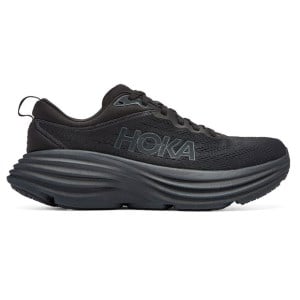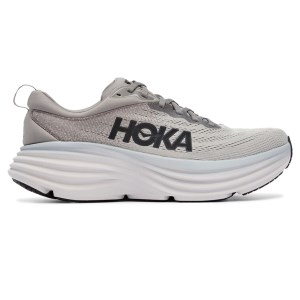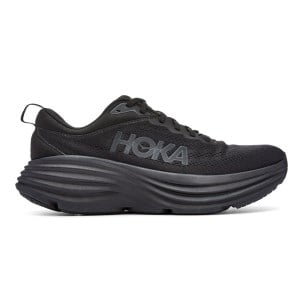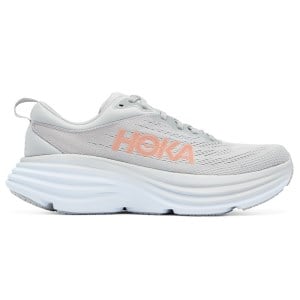Hoka One One Bondi 8 vs 7 Comparison Running Shoe Review
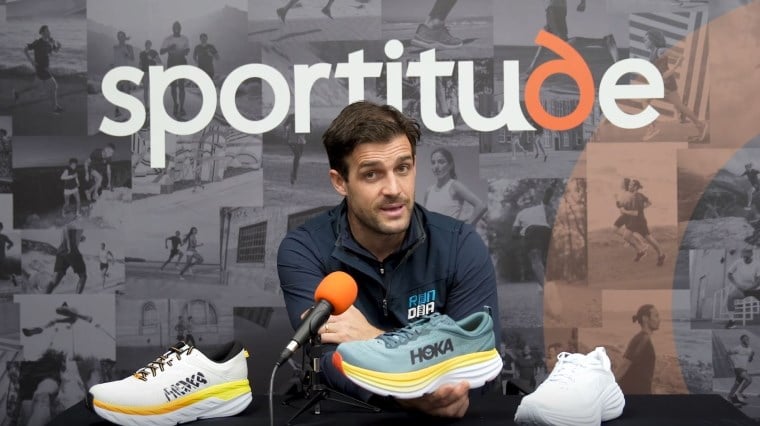
Sportitude’s in-house running shoe expert Josh Willoughby reviews the Hoka One One Bondi 8 and compares it with the Hoka One One Bondi 7, highlighting the updates that makes this max cushioned ride running shoe royalty when it comes to comfort. Being on a 4mm heel-to-toe offset, it's stacked up high while positioning your feet on a relatively natural slope within the shoe.
The Hoka Bondi 8 is a neutral shoe that provides mountains of protection underfoot and is free of the J-Frame support technology of its max cushioned cousin the Hoka One One Gaviota, which is targeted specifically to overpronators.
In the Hoka Bondi franchise, cushioning is prioritised over a lightweight ride. Being on a protective platform, runners will gravitate to the Hoka Bondi 8 for everything from easy-going high mileage runs to your daily training. It's also a favourite for recovery runs, providing on-the-go luxury to fatigued feet after a challenging training session or race, while taking the pressure off common running injuries such as plantar fasciitis.
The outsole provides ever-reliable coverage, with low impact areas exposed while high-stress areas are reinforced with durable rubber for heel striker friendly engineering. Deeper flex grooves work together with the rocker sole geometry to aid in compression on impact, absorbing shock so your hard-working feet don’t have to.
The Hoka Bondi 8 provides plenty of surface area beneath the foot to keep you stable on the dense and plush midsole – complementing the high levels of cushioning. Fine-tuned for distraction-free comfort, an engineered mesh upper creates a breathable and supportive wrap around your feet to clock up the breezy and effortless-feeling kilometres ahead.
Check out the review with full transcript below.
Hey guys, welcome to Sportitude Running. My name is Josh and today we have a pretty honest, consistent or whatever you'd like to call it shoe review. Right in front of me I have the Hoka One One Bondi 8 and to my right I have the Hoka One One Bondi 7.
In today's review we're going to be comparing the two side by side, talk all things outsole, midsole and upper and give you information about this running shoe. Whether it is through reputation or not, the Hoka Bondi franchise has been the king and the queen of the max cushioned category for a decade now.
It has been a very popular shoe for a lot of our podiatry and physiotherapy referrals looking to address issues. Be it forefoot pathology issues or any sort of load reduction we can do through the metatarsal heads, we have brought up the Hoka Bondi as a good starting point.
In today's review we'll get into the outsole, midsole and the upper and compare them side by side to give you all the information that you need at home to potentially make this your next max cushioned shoe purchase. Without further ado let's get stuck in.
Runner Profile
First things first, this shoe is a neutral shoe. The Hoka One One Gaviota is their max cushioned shoe which is designed for the overpronator. However, the runner who the Hoka One One Bondi 8 is pitched for has not changed. It's dialled in for that neutral foot type. Therefore, on the medial side there's no additional gradient or J-Frame support which is what Hoka One One have been using for a decade.
They have looked at this shoe and engineered it for that neutral foot type. However, like a lot of shoes out there I am a mild overpronator and I found the Hoka Bondi 8 very comfortable for my long daily runs or my easy runs out on the road.
The other thing we need to address is where it sits in your shoe rotation. It targets two areas to be honest. You’re going to have someone who's going to buy this and use it two to three times a week as their long day shoe or their everyday shoe for those easy runs out in the road.
However, there be a cohort of runners that may find it a little bit heavy and maybe a bit too dense. They will use this shoe purely and simply for recovery days where you're a bit beaten up, be it from a race or a really hard workout. The next day you've got to back it up with a slow easy day run. If you're that runner, the Hoka Bondi 8 is going to cater quite well for you because it's extremely well cushioned and with that rocker sole throughout the forefoot you're going to find it a really easy shoe to exit out of your gait cycle.
Outsole
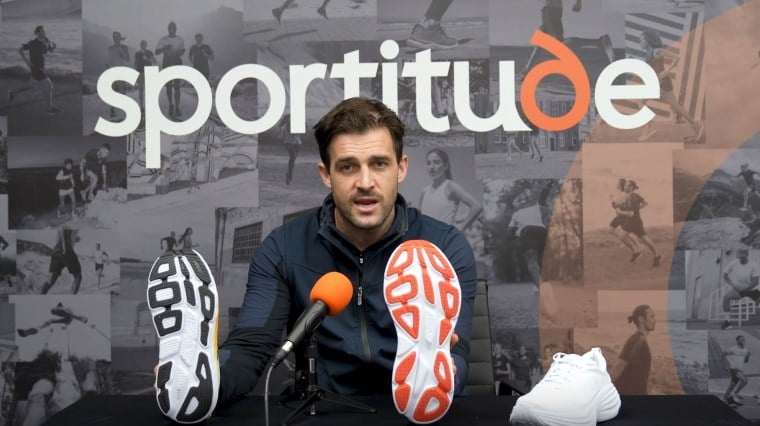
Let's dial into the fun part of all my shoe reviews and start talking about how this shoe is put together. Let's look at the outsole first side by side next to the Hoka One One Bondi 7. Not a lot has changed. You have a really good surface area, plenty of outsole on offer and there's a little bit of exposed Hoka EVA throughout the midfoot or mid part of the Hoka One One Bondi 8.
However, it's probably more to do with the decoupled lines. They’re a bit deeper in the back of the shoe in comparison to where they were last year. For heel strikers that means you're going to be able to compress that midsole compound more on your entry, so you get a bit more compression or cushioning.
Coming through to the forefoot you can see there's a couple of vertical lines on offer which is again going to complement what this rocker sole does and that's more to do with the midsole part of this shoe review.
There’s plenty of surface area with that outsole coverage. The only real exposed areas are through the midfoot and the medial side. Don't be alarmed, that's not a really high-wearing or high friction area. A lot of the high impact is going to be through the lateral part of that heel and the lateral part of this midfoot. That's been addressed with the outsole coverage, and as we touched on it's not too dissimilar to what we had last year.
Upper
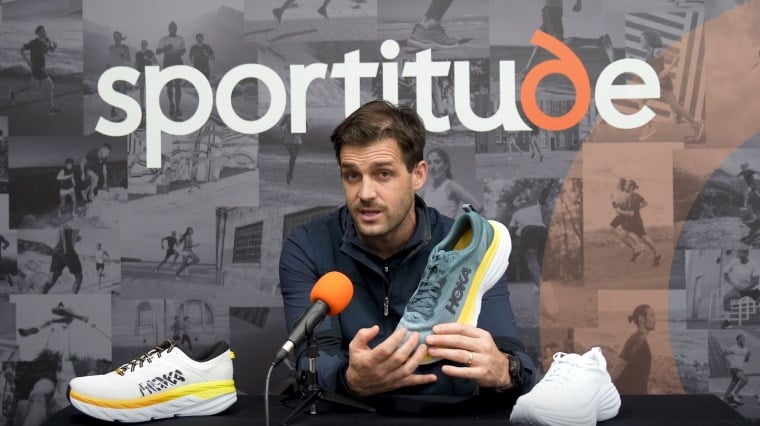
Coming to the upper of this shoe, what we have is an engineered mesh. It's a mesh that's going to provide enough support for your long runs out on the road but you're also going to get enough ventilation. It's not the thinnest mesh upper on the market and nor would you expect that because this shoe is not designed to be a lightweight shoe, it's designed to be a really comfortable, cushioned shoe.
When we talk about comfort and cushioning, a lot of the attention is focussed on what's underneath the foot and little attention is given to what's on top of the foot. In the case of the Hoka One One Bondi 8, the tongue is a little bit thicker in my opinion than where it was last year. Is that a good thing or is that a bad thing? Only time will tell.
I find it pretty comfortable and to be fair you can always adjust your laces to be whatever you require for the amount of depth you need. Sometimes runners miss an eyelet here or there to get the appropriate amount of depth. It's totally up to you how you want to conform that lacing construction, however with a shoe like this it's all about comfort. If I can get a slightly more cushioned feel on top of my arch, I will go for it. I like how this shoe feels personally.
The tongue is still thin enough to get a little bit of ventilation through it, but as I addressed earlier it's a little bit thicker than last year's Hoka One One Bondi 7.
The other thing to note is the internal heel counter at the back. It’s the same thing as last year's model but it is a little bit shallower. If you've been using the Hoka Bondi 6 and the Hoka Bondi 7 and you had an orthotic, you want to make sure that you get the right fit with your Hoka Bondi 8 and your orthotic has the appropriate amount of depth on play to sit inside this shoe.
You can use that last eyelet to get a heel lock lace to give you the security you require. However, don’t assume that your orthotic from a Hoka Bondi 7 is going to feel, fit and perform as well as it does in the Hoka Bondi 8. You really need to make sure that it's going to be A-OK.
Coming through to the forefoot, in my opinion this shoe is marginally shallower than what we had last year and that's probably going to come more into play when you get towards the last 10% to 15% of the life of this shoe.
The Hoka Bondi 7 fitted pretty well, however the Hoka Bondi 6 and Hoka Bondi 7 had a consistent trend. Once your shoes got toward the back end of their life, because the foam pressed down a little bit we found them to fit a little bit deeper.
More often than not we really had to keep adjusting that lace on top to get the secure fit and feel we need because the shoe kept getting deeper and deeper through the toe box. I think they've addressed that by being a little bit shallower from the get-go. Where that will come into play is when the shoe gets towards the last chapter of its life where you won't be having to adjust the top of the lace too much to get that dialled in fit.
Midsole
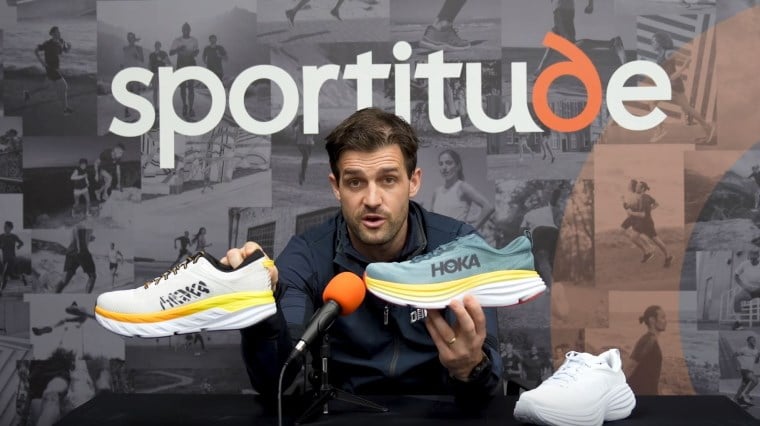
Let's talk all things midsole with this shoe because let's be honest, this is where this shoe has its reputation of being max cushioned. There’s a lot of shoe under the foot and that rocker configuration through the forefoot. We have a 33mm heel and 29mm forefoot for an offset of 4mm in the men's model.
Like some brands out there Hoka One One engineer their men's and women's shoes to be marginally different. In the women’s model we have a 31mm heel and 27mm forefoot. It’s still a 4mm offset but a slight reduction in stack height with that running shoe.
Max cushioned means you're going to have a lot of compression underneath your foot. The midsole in terms of its overall stack and numbers is very similar to where it was last year in the Hoka One One Bondi 7 and the Hoka One One Bondi 6.
However, with the visual aspect of this shoe you can see the execution where they've put those little flex grooves in the midsole on the lateral side and the medial side. They have been strategically placed almost like a gradient layer level. Over time the shoe will compress in the right areas.
The biggest change isn't in the amount of cushioning, it's more to do with the surface area. I could have touched on this in the outsole part of this review, but it's probably more relevant to the midsole. You can see the contrast of colour from the yellow to the grey, the upper being the grey and the yellow being the midsole, and there's quite a lot of width on offer for either side of that upper.
That means that for the foot type out there that sits on top of this platform, you're going to get a lot of stability, simple as that. If you have a tendency in your runs to overpronate slightly which is a category I fall into, you still get a lot of medial support purely and simply because you have a lot of extra built up walls on that medial side and lateral side. If someone happens to be a late stage supinator, this running shoe will still hold up quite well in the back end of your long runs.
The other thing which I touched on in the outsole part of this review is that these decoupled lines are marginally deeper than what they were last year in the Hoka Bondi 7. When you hit the ground as a heel striker, you get a fair bit more cushioning because they have made those flex grooves a bit deeper in the outsole.
As you come through to midstance, there’s different layers of flex grooves from the back of the shoe to the forefoot, and it almost looks like it dips down like a rocker sole. That's where that midsole performance and cushioning performs the same from the midstance to the toe-off phase of the gait cycle.
As I touched on in my intro part of this shoe review, the vast majority of purchases over the last few years for us here at Sportitude Running and I’d argue it's probably the same with a lot of speciality running shoe stores, is that we tend to have a lot of referrals for this shoe from your podiatrists and physiotherapists.
They’re trying to get their walkers or runners to take load off their forefoot, whether it be due to forefoot pathology issues, any sort of inflammation, swelling and build-up of arthritis with regards to the metatarsals of the forefoot
It's about finding ways we can take some load off that front half of the shoe. The rocker sole does take a considerable amount of load off of the exit of your gait cycle. That's the same for running as it is for walking. We tend to sell a lot of these shoes just for walkers and that's absolutely fine, there's nothing wrong with that.
However, the Hoka Bondi 8 is a running shoe. It's designed for max performance and max cushioning out on the road. If you're thinking about taking load off your forefoot when you're walking, naturally it's going to be the same for when you're running.
Taking a lot of load off that front half of your foot is going to make your long and easy runs a lot more comfortable and more effortless to be fair. That's where this shoe has been really well received for people looking at their recovery runs that bashed themselves up the day before with a race or a session and the following morning they wanted to turn their legs over. The Hoka Bondi has always been a very popular option for those runners.
The Wrap Up
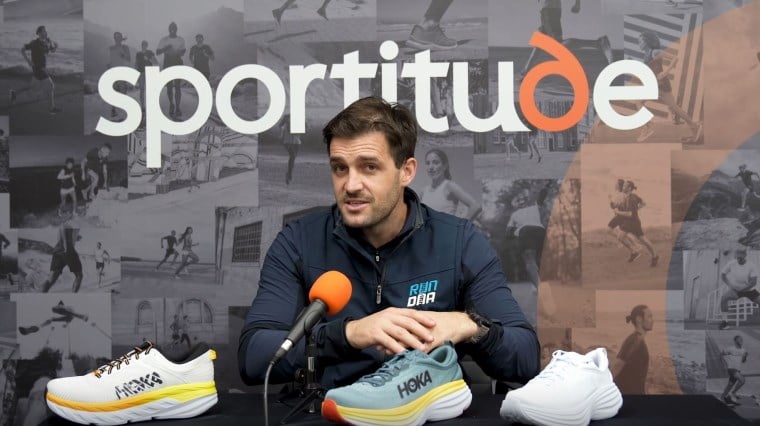
In summarising, we've addressed that the Hoka One One Bondi 8 is a max cushioned neutral shoe. It is the king of the rocker soles. As I said, whether that's through reputation or through performance is a subjective opinion. However, Hoka One One really did change the way shoes were engineered. When they landed well over a decade ago, they started to change how brands addressed fit, feel and performance - I think it's fantastic. The progression of Hoka and the progression of the Hoka Bondi franchise has been sensational.
The Hoka One One Bondi 6 and Hoka One One Bondi 7 are very similar. They’re still a very popular shoe but what we have with the Hoka Bondi 8 right now in my opinion is more runnable. It's probably a little bit more dialled in for your runner.
Like I said a minute ago, we still sell a lot of Hoka Bondi to walkers, mainly through referrals from our podiatry and physiotherapy partners. However, the Hoka Bondi 8 is probably the most runnable Bondi that I can remember in the last few years and that is a good thing, because it's a running shoe.
What other shoes come into the same conversation? As I said it is probably the king and the queen of this category. However, if you've had a look at the New Balance Fresh Foam More over the last couple of years, Asics Glide Ride 3 or Saucony Endorphin Shift, we could also have a conversation about whether the Bondi is going to be right for you. These are all max cushioned shoes with an the element of rocker technology through the front half.
The Hoka Bondi 8 is not the lightest shoe out there, let's just address that straight off the bat. It's not designed to be light. It's around 304 grams in a men's size 9 and 260 grams in a women’s size 7. It's not overly heavy but it's not really light. It's designed to be comfortable and it is exactly that.
If you're a Hoka One One lover, let us know why you love Hoka and contact our Sportitude shoe experts if you have any questions about Hoka Bondi 8, the Hoka Bondi 7 and where they have come from. They have a cult following and a lot more people are jumping onto that bandwagon and love what Hoka represent.
Please subscribe to the Sportitude YouTube channel, hit the bell to stay notified and we'll keep pumping out shoe reviews for you the running community all over the world. Wherever you are the northern hemisphere or the southern hemisphere, we love to help you find the best fitting running shoes so you can enjoy your running experience and your running journey.
Until next time stay safe, be kind to one another, happy running and we'll see you on the road. Take care.
FEATURES
- Support: Neutral
- Upper: Mesh
- Midsole: Hoka One One EVA
- Offset / Drop: 4mm
Men
- Heel Height: 33mm
- Forefoot Height: 29mm
- Weight: 304g / 10.7oz (US 9)
- Width: D (standard), 2E (wide), 4E (extra wide)
Women
- Heel Height: 31mm
- Forefoot Height: 27mm
- Weight: 260g / 9.2oz (US 7)
- Width: B (standard), D (wide)
For a more in-depth shoe fitting experience, you can book a free 15 minute video chat in a Live Fit session or make an appointment to discover your RunDNA at Sportitude Running@Hindmarsh.
Happy running!

